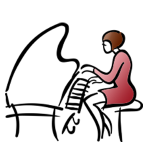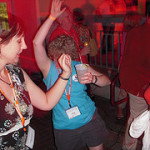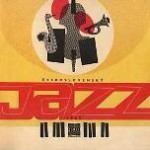I decided that since I so brazenly hijacked the ax[1] of the washboard player in Chubby Carrier‘s band — his name is Earl Sally, by the way — the least I could do is make an effort to learn a little more about the instrument.
First off, its proper Cajun-French name is the frottoir, or, in English, the rubboard. Its origin as a clothes-washing tool is all but lost in the mists of time — for which we can be grateful, n’est-ce pas? 😉
The rubboard has no wooden frame like a washboard typically does; it’s simply a sheet of corrugated metal, with large curved “hooks” at the top that go over the player’s shoulders. It’s much more comfortable to wear than it looks — at least that’s my recollection, which was, I confess, slightly margarita-enhanced. 😛
The instrument was designed specifically for zydeco music, the product of a collaboration in the mid-1940’s between zydeco musicians (and brothers) Clifton and Cleveland Chenier, and their metalworker friend Willie Landry.[2] Willie’s son Tee Don Landry carries on the family tradition, making rubboards by hand in Lousiana. His website has the rest of the rubboard story, plus videos demonstating rubboard playing!
I checked them out, because I was curious to see if my attempt at wielding the spoons was even in the ballpark. Here’s the basic zydeco beat:
Hmm… that’s not too complicated — steady eighth notes with one hand, single strokes on beats 2 and 4 with the other. For those of you who are hip to the notation jive, it looks like this:
I believe, though, that when I had my big moment in the spotlight, it didn’t occur to me that the hands could be so independent. Shame on me, I’m a pianist! But like I said, there were extenuating circumstances. To the best of my recollection, I did something kinda like this:
Not as interesting, but the enthusiasm was there!
Couple more rubboard fun facts that I learned from Tee Don’s site:
- The Smithsonian now has a rubboard in its collection, thanks to Tee Don’s advocacy.
- There’s a rubboard specially designed for women, with an attractive shapely design. But I have to ask: where are the matching shoes and handbag?! 😉
So there you have it: my tequila-fueled antics led to a musical learning experience! Please, kids — don’t try this at home! 😀

If you enjoyed this post, would you consider…
Thanks — you make the world a better place! 🙂
[1] “Ax,” by the way, is how super-cool, extra-hep music cats refer to their instruments. As in, “Oh, sh!#, I left my ax in the cab!”
Here’s another term you can use to increase your musical street cred: any brass or single-reed instrument can be referred to as a “horn,” even if that’s not its proper name. Trumpet, clarinet, sax — but not oboe, as far as I know. Those double-reed players are sticklers for precision! 😉
[2] Landry, Don. “Key of Z Rubboards Made by Tee Don.” Key of Z Rubboards Made by Tee Don. 25 Jul 2008.






